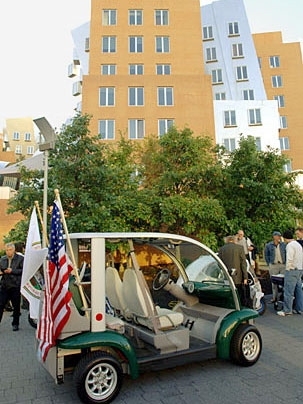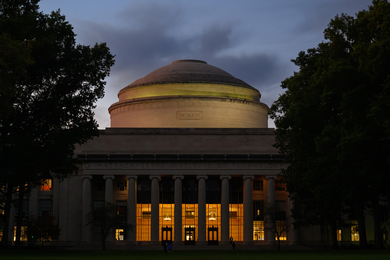They looked incongruous as they pulled past the Chevrolets and Toyotas in East lot--an antique Stanley Steamer, a yellow-striped city bus, a motorcycle with a passenger seat made from a diner's counter stool, a tanker with a bucolic scene painted on the side and dozens more. In they rolled, horns honking amid the occasional deep "ooooh-gah" of the steam car's Klaxon.
The AltWheels caravan of 46 environmentally friendly vehicles had arrived at MIT's Stata Center amphitheater.
AltWheels--the second New England event of its kind--is an all-volunteer, multiday, multivenue event designed to raise public awareness of commercially available vehicles that provide alternatives to the gasoline-powered automobile.
"Even though the price of fuel dropped 20 cents, there's a need for this," MIT Chancellor Phillip L. Clay told the crowd of drivers, inventors and curious onlookers. "With Ford and others, MIT works hard with industry to advance fuel and energy research. This caravan represents the work of many at MIT."
John Heywood, director of the MIT Sloan Automotive Laboratory, said he's been involved in the automotive field "a long time, but it's never been this lively and exciting."
As the Hood blimp circled overhead, a crowd milled around the vehicles--some ordinary in appearance, others that seemed out of place on a city street. There was the Moonbeam, which Maine inventor Jory Squibb called "an experiment in resource-stingy transportation." A tiny three-wheeled contraption built from secondhand motorcycle parts, the Moonbeam gets up to 100 mpg, and Squibb uses it for 90 percent of his travel needs. Retired electrical engineer David K. Nergaard drove his circa-1890 Stanley Steamer, a steam-powered vehicle that attracted a covey of MIT students who peered at its parts as they puzzled out its principles.
Our environmental problems, Heywood said, boil down to this: "There's too many of us, we use too much stuff and we use it in damaging ways." The range of alternatives to typical gas-guzzling vehicles is now wide enough to help people make personal choices "about how we live and how we drive. We can drive small and light," Heywood said. "We can use less stuff and use it less damagingly."
The caravan, escorted by an environmentally friendly state police cruiser from the Larz Anderson Auto Museum in Brookline, Mass., to MIT, kicked off this year's AltWheels festival. Events included a speaker series at the Museum of Science last weekend and opportunities to meet inventors and see futuristic vehicles on Boston's City Hall Plaza Sept. 22-23 and at the Larz Anderson museum Sept. 24.
In addition to Clay and Heywood, the Sept. 21 event at MIT featured remarks by Simon Pitts, executive director of the Ford-MIT Alliance; Scott Griffith, CEO of ZipCar; James W. Hunt, chief of environmental and energy services for the City of Boston; David Cash, director of air, energy and waste policy at Massachusetts Executive Office of Environmental Affairs; Massport CEO Tom Kinton; and Alison Sander, founder of the AltWheels Festival.
The caravan was co-hosted by MIT's Environmental Programs Office and the MIT Laboratory for Energy and the Environment. For more information, see the AltWheels site at www.altwheels.org/caravan.html.
A version of this article appeared in MIT Tech Talk on September 27, 2006 (download PDF).






